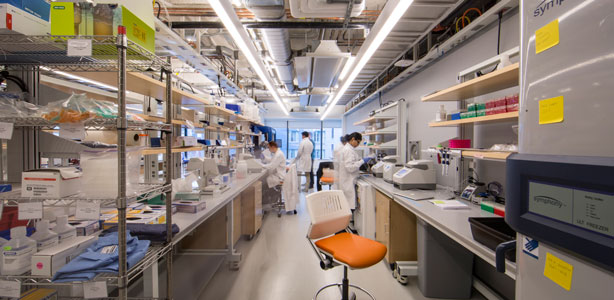A computer may soon be able to offer highly personalized treatment suggestions for cancer patients based on the specifics of their cases and the full sweep of the most relevant scientific research.
IBM and the New York Genome Center, a consortium of medical research institutions in New York City, are collaborating on a project to speed up cancer diagnoses and treatment.
The work, which got underway in 2013, is exploring the use of computers to help analyze a wide range of genetic information and the scientific literature with the goal of quickly formulating precise treatment plans for cancer patients.
The line of research is being orchestrated by Robert Darnell, the founding director of the New York Genome Center and a neuro-oncologist at Rockefeller University. A project on brain tumors aims to bring cancer experts in New York City to bear on treatment plans that take advantage of the very latest scientific evidence.
An essential assistant on Darnell’s team is supercomputer IBM Watson, which helps by comparing the genetic differences between healthy cells and tumor cells in patients, as well as fetching the newest treatment ideas from medical journals.
Watson wasn’t always part of Darnell’s lineup. When he started the project, he relied on the collective brainpower of a bunch of medical researchers in New York City. Fifteen of them, including Darnell, spent three weeks evaluating the case of the first patient of the project. But, he says, “by the time we got through with this patient, the patient died.”
Speed matters, given how fast cancer can spread. Information overload is a particular challenge.
“Cancer is not giving you the luxury of time,” says Ajay Royyuru, the director of IBM’s Healthcare and Life Sciences Research. And, he adds, there are “more papers published in each year than cancer researchers can read and remember.”
New York Genome Center Center has more DNA sequencing capacity than any other single institution in New York City.
Courtesy of New York Genome Center
In contrast, IBM’s supercomputer Watson, famous for defeating former champions in Jeopardy! in 2011, is able to read “800 million pages per second … from medical literature to patient records to doctors’ notes,” according to Christine Douglass at IBM Watson Health.
Upon learning about Watson’s abilities, Darnell approached IBM. By 2014, a human-computer coalition to fight cancer was born.
“Compare what the genetics in the healthy cell looks like to what the genetics in the cancer cell looks like, you get the list of differences,” says Steve Harvey, vice president of Watson Health at IBM. “Watson will first try to figure out what are the differences that could be causing cancer. For each of those potential genetic issues, it will go through databases and literature to find” known treatment options, he says.
With the help of Watson, Darnell’s group studied 30 patients with glioblastoma, an aggressive form of brain cancer, and developed personalized treatment options for each patient “based on genetic mutations present in the tumor,” according to Darnell. Darnell declined to comment on the specifics of the findings before they’re published. But, he says, “there are patients who will benefit” from this study. A preliminary report on the findings has been submitted to The Journal of Clinical Oncology.
Both IBM and the New York Genome Center are moving on to find out whether Watson can apply what he learned from Darnell’s research to a larger group of glioblastoma patients.
“We’ll be working with the Veterans Health Administration,” says Harvey. According to Harvey, “The VHA overseas the largest population of cancer patients — 3.5 percent of all cancer patients in the US are from the VHA.”
According to Darnell, the paper his group submitted will “lay the groundwork for the larger, more comprehensive paper on the same study.” Darnell says the current research project is not yet a clinical trial, and he hopes to execute a large-scale clinical trial in the future, recruiting “any cancer patient who is sick, not necessarily from glioblastoma.”
“It’s not going to be doable without the machines,” says Darnell.
